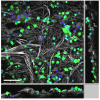Intraoperative use of enriched collagen and elastin matrices with freshly isolated adipose-derived stem/stromal cells: a potential clinical approach for soft tissue reconstruction
- PMID: 24555437
- PMCID: PMC3936703
- DOI: 10.1186/1471-2482-14-10
Intraoperative use of enriched collagen and elastin matrices with freshly isolated adipose-derived stem/stromal cells: a potential clinical approach for soft tissue reconstruction
Abstract
Background: Adipose tissue contains a large number of multipotent cells, which are essential for stem cell-based therapies. The combination of this therapy with suitable commercial clinically used matrices, such as collagen and elastin matrices (i.e. dermal matrices), is a promising approach for soft tissue reconstruction. We previously demonstrated that the liposuction method affects the adherence behaviour of freshly isolated adipose-derived stem/stromal cells (ASCs) on collagen and elastin matrices. However, it remains unclear whether freshly isolated and uncultured ASCs could be directly transferred to matrices during a single transplantation operation without additional cell culture steps.
Methods: After each fat harvesting procedure, ASCs were isolated and directly seeded onto collagen and elastin matrices. Different time intervals (i.e. 1, 3 and 24 h) were investigated to determine the time interval needed for cellular attachment to the collagen and elastin matrices. Resazurin-based vitality assays were performed after seeding the cells onto the collagen and elastin matrices. In addition, the adhesion and migration of ASCs on the collagen and elastin matrices were visualised using histology and two-photon microscopy.
Results: A time-dependent increase in the number of viable ASCs attached to the collagen and elastin matrices was observed. This finding was supported by mitochondrial activity and histology results. Importantly, the ASCs attached and adhered to the collagen and elastin matrices after only 1 h of ex vivo enrichment. This finding was also supported by two-photon microscopy, which revealed the presence and attachment of viable cells on the upper layer of the construct.
Conclusion: Freshly isolated uncultured ASCs can be safely seeded onto collagen and elastin matrices for ex vivo cellular enrichment of these constructs after liposuction. Although we observed a significant number of seeded cells on the matrices after a 3-h enrichment time, we also observed an adequate number of isolated cells after a 1-h enrichment time. However, this approach must be optimised for clinical use. Thus, in vivo studies and clinical trials are needed to investigate the feasibility of this approach.
Figures




Similar articles
-
The LipoDerm Method for Regeneration and Reconstruction in Plastic Surgery: A Technical Experimental Ex Vivo Note.Med Sci (Basel). 2023 Feb 3;11(1):16. doi: 10.3390/medsci11010016. Med Sci (Basel). 2023. PMID: 36810483 Free PMC article.
-
Conventional vs. micro-fat harvesting: how fat harvesting technique affects tissue-engineering approaches using adipose tissue-derived stem/stromal cells.J Plast Reconstr Aesthet Surg. 2013 Sep;66(9):1271-8. doi: 10.1016/j.bjps.2013.04.015. Epub 2013 Jun 2. J Plast Reconstr Aesthet Surg. 2013. PMID: 23732072
-
Adipose-derived stem-cell-seeded non-cross-linked porcine acellular dermal matrix increases cellular infiltration, vascular infiltration, and mechanical strength of ventral hernia repairs.Tissue Eng Part A. 2015 Feb;21(3-4):475-85. doi: 10.1089/ten.TEA.2014.0235. Epub 2014 Oct 2. Tissue Eng Part A. 2015. PMID: 25156009 Free PMC article.
-
From liposuction to adipose-derived stem cells: indications and technique.Acta Biomed. 2019 May 23;90(2):197-208. doi: 10.23750/abm.v90i2.6619. Acta Biomed. 2019. PMID: 31124996 Free PMC article. Review.
-
2010 Nicolas Andry Award: Multipotent adult stem cells from adipose tissue for musculoskeletal tissue engineering.Clin Orthop Relat Res. 2010 Sep;468(9):2530-40. doi: 10.1007/s11999-010-1410-9. Epub 2010 Jul 13. Clin Orthop Relat Res. 2010. PMID: 20625952 Free PMC article. Review.
Cited by
-
Donor-dependent variances of human adipose-derived stem cells in respect to the in-vitro endothelial cell differentiation capability.Adipocyte. 2017 Jan 2;6(1):20-32. doi: 10.1080/21623945.2016.1273299. Epub 2017 Jan 13. Adipocyte. 2017. PMID: 28452591 Free PMC article.
-
Ginsenoside Rg1 and platelet-rich fibrin enhance human breast adipose-derived stem cell function for soft tissue regeneration.Oncotarget. 2016 Jun 7;7(23):35390-403. doi: 10.18632/oncotarget.9360. Oncotarget. 2016. PMID: 27191987 Free PMC article.
-
The LipoDerm Method for Regeneration and Reconstruction in Plastic Surgery: A Technical Experimental Ex Vivo Note.Med Sci (Basel). 2023 Feb 3;11(1):16. doi: 10.3390/medsci11010016. Med Sci (Basel). 2023. PMID: 36810483 Free PMC article.
-
Adipose Stem Cells: From Bench to Bedside.Stem Cells Int. 2016;2016:6484038. doi: 10.1155/2016/6484038. Epub 2016 Mar 21. Stem Cells Int. 2016. PMID: 27087816 Free PMC article. No abstract available.
-
Combined ultrasound and photoacoustic imaging to noninvasively assess burn injury and selectively monitor a regenerative tissue-engineered construct.Tissue Eng Part C Methods. 2015 Jun;21(6):557-66. doi: 10.1089/ten.TEC.2014.0306. Epub 2015 Jan 19. Tissue Eng Part C Methods. 2015. PMID: 25384558 Free PMC article.
References
-
- Fraser JK, Zhu M, Wulur I, Alfonso Z. Adipose-derived stem cells. Methods Mol Biol. 2008;449:59–67. - PubMed
-
- Alharbi Z, Opländer C, Almakadi S, Fritz A, Vogt M, Pallua N. Conventional vs. micro-fat harvesting: how fat harvesting technique affects tissue-engineering approaches using adipose tissue-derived stem/stromal cells. J Plast Reconstr Aesthet Surg. 2013;66(9):1271–1278. doi: 10.1016/j.bjps.2013.04.015. - DOI - PubMed
Publication types
MeSH terms
Substances
LinkOut - more resources
Full Text Sources
Other Literature Sources

